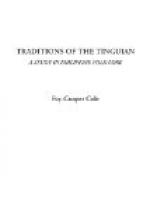Up to this time in our reconstruction of the life of “the first times” we have mentioned nothing impossible or improbable to the present day Tinguian, although, as we shall see later, there are some striking differences in customs and ideas. We have purposely left the description of the people and their practice of magic to the last, although their magical practices invade every activity of their lives, for it is here that the greatest variations from present conditions apparently occur.
These people had intimate relations with some of the lesser spirits, especially with the liblibayan [26], who appear to be little more than their servants, with the evil spirits known as banbanayo, and with the alan (p. 123). The alan, just mentioned, are to-day considered as deformed spirits who live in the forests: “They are as large as people but have wings and can fly; their toes are at the back of their feet and their fingers point backwards from their wrists.” The several references to them in the tales such as “you alan girls whose toes on your feet turn out” indicate they were so considered in the first times (p. 161). Some of them are addressed as “you alan of the springs,” and in one instance a man dives down into the water where the alan live (p. 148), but in general their homes seem to be similar to but much finer than those of the people of Kadalayapan and Kaodanan. These spirits appear time after time as the foster mothers of the leading characters: Generally they secure a drop of menstrual blood, a miscarriage, or the afterbirth, and all unknown to the real parents, change them into children and raise them (p. 83). These foster children are pictured as living in houses of gold situated near springs, the pebbles of which are of gold or beads; [27] the places where the women set the pots while dipping water are big plates or dishes, while similar dishes form the stepping stones leading up to the house. Articles of gold are found in the dwellings and valuable jars are numerous. When the true relationships of these children are established they always go to their blood parents, carrying with them these riches, which are a source of wonder and comment (pp. 43, 64).
The people of Kadalayapan and Kaodanan have many dealings with the celestial bodies. The big star Bagbagak appears as the husband of Sinag—the moon—and father of the star maiden Gaygayoma, who, Aponitolau assures his wife, is a spirit. When this girl comes down to steal sugar-cane she takes off her star dress and appears as a beautiful maiden; [28] she becomes enamored with Aponitolau and takes him to the sky, where he lives with her. They have a child, who later marries in Kadalayapan and thereafter stays below. Upon the occasion when Aponitolau visits his first wife and fails to return to the sky at the appointed time, a great company of stars are sent to fetch him, with orders to devour him if he refuses to obey (p. 109, ff.).




